- Home
- Tom Clancy
Conviction (2009) Page 8
Conviction (2009) Read online
Page 8
He set up camp—a tent, lawn chair, cooler, and a clothesline from which he hung a few items of clothing—then called Vesa Hytönen’s apartment, got the machine, demanded that “Heinrich” pick up immediately, then cursed, and hung up. Next he used his iPhone to log into the Lycos e-mail account, typed up his query, and saved it as a draft.
While waiting for a response, he went for a hike, using his handheld Garmin 60Cx GPS unit to time himself and mark waypoints. From his campsite to the lake it was 1.32 miles—forty minutes at a leisurely pace. He added 30 percent to that figure to account for darkness and another 30 percent to account for potential pursuers. So, roughly two hours and fifteen minutes round trip. He saw only three other hikers, none of them equipped with anything more robust than a lumbar pack. Day travelers. In all likelihood he’d have no company on the trail later.
He checked his watch. Eight hours until nightfall.
HE spent the remainder of the afternoon at his campsite, sitting by the fire, eating hot dogs, drinking beer (non-alcoholic to keep a clear head), whittling, and generally behaving like a normal camper until six o’ clock, when he climbed into his tent and closed his eyes. He was awoken ten minutes later by his iPhone’s incoming e-mail chime. It was Vesa:Data Guardians Inc. (DGI) a privately owned Luxembourg company. Specializes in home networking, information security, and storage. Our mutual friend investigated. According to internal company records, DGI installed IBM System x3350 server two months ago; routinely scheduled maintenance call logged this date. Service-fee schedule suggests special-needs installation. Details, countermeasures, penetration software available no later than 2100 local time via uplink. Remote penetration problematic; physical link required.
Fisher mentally translated Vesa’s message: DGI designed and installed a beefed-up file-storage server for Yannick Ernsdorff. Fisher’s OPSAT would be updated with everything he needed to do the hack, but he had to be plugged into Ernsdorff’s server first.
HE slept for five hours, waking shortly after eleven. He strolled to the bathroom/shower shelter at the center of the grounds, then walked back. No one else had checked in during the day. His neighbors, the blond couple, had retired to their tent for the night, and he could see their silhouettes in the yellow glow of a lantern.
Back at the Range Rover, he carried the Pelican case into the tent. He powered up the OPSAT, waited for it to run through its self-diagnostics, then called up the COMMS screen and initiated the uplink. As promised, the update was waiting. He watched the progress bar crawl across the screen until it reached 100 percent, then waited as the OPSAT recycled. He took a moment to review the package, which included a spec sheet and schematic of the IBM System x3350, then read through the hack instructions. Next he called up the map of the area and punched in the latitudes and longitudes he’d recorded throughout the day; they appeared on the OPSAT’s screen as pulsing red pushpins. He tapped the one representing his campsite and the screen zoomed and recentered: WAYPOINT 1 RECORDED. He set the OPSAT to STANDBY. He donned his tac-suit and gear, then returned the case to the Range Rover and locked up. Finally, he scanned the campgrounds with NV and IR and found it still empty, save for his Rastafarian friends, who appeared to be asleep, their prostrate forms coming through in infrared shades of blue, yellow, and red.
Fisher ducked onto the trail and headed out.
10
HAD he been operating on a strict schedule, it would have been derailed in the first ten minutes. A hundred yards over the bridge he heard faint voices down the trail. He slipped into the undergrowth and scanned ahead. The NV showed little, so dense were the trees; the IR wasn’t much better, but patience paid off, after thirty seconds of watching, as he caught glimpses of four ghostly rainbow shapes moving through the trees. They were approaching. Fisher switched the IR to standby and huddled down to wait. As the group approached he smelled cigarette smoke and heard giggling. Teenagers, he thought. Two boys and two girls. As the group drew even with his hiding place, it turned onto a smaller trail and stopped at a picnic site. A small fire crackled to life. Fisher could see the four of them sitting on fallen logs around the flickering light. Clearly they wouldn’t be moving on anytime soon.
Moving on flat feet, Fisher backed away from the trail. When he’d put enough distance between himself and the teenagers, he turned back to the east and began picking his way through the trees until he’d looped back to the main trail. Forty minutes later he heard a double beep in his subdermal, indicating he’d reached his final waypoint. He was now within a couple of hundred yards of the western edge of Ernsdorff’s estate. He stopped and did an IR/NV scan and was about to move on when something caught his eye to the right: a too-straight vertical line among the trees. His first thought was a sensor or camera. Keeping his eye on the object, Fisher picked his way closer until he could identify what he was seeing: a diamond-shaped sign atop a fence post. In what he assumed was red lettering on a white background, it stated in Luxembourgish, German, and English: PRIVATE PROPERTY—KEEP OUT.
Either Ernsdorff had claimed a bit more land than he owned or the survey maps and records were mistaken; from what few glimpses Fisher got from Google Earth, the brick wall surrounding the grounds lay three hundred yards ahead. Either way, the sign told him something he’d already suspected: Ernsdorff and/or his security consultants had decided he wasn’t a high-value target, at least for murder or kidnapping. People who are truly concerned about their personal safety don’t try to warn off attackers, but rather they let their security measures handle intruders. Fisher would, of course, be thorough, but it was unlikely Ernsdorff had guards roving the property. If there was security here, it would likely be found inside and in close proximity to the house itself.
Fisher spent the next twenty minutes mapping sign placements, adding digital pushpins to his OPSAT, until he had the western edge identified. Near each sign he had stopped to scan the ground ahead with night vision, infrared, and electromagnetic, and each time he saw nothing bothersome. He continued forward, taking his time, sidestepping twigs and fallen branches, occasionally cycling through the Tridents’ settings until at last the outer wall came into view. Unlike the wall he’d photographed on the lakeside of the property, this one was higher, perhaps six feet, and topped with shards of jagged ceramic embedded in mortar. This was of little concern to Fisher; the shards would barely scratch his RhinoPlate. What concerned him was what he saw when he studied the wall with the Tridents’ EM mode: Every third brick in the row just below the shards was pulsing with energy. The Tridents’ EM wasn’t sophisticated enough to tell him the precise nature of the energy, but experience told him radio waves. Fisher zoomed in and switched to night vision, then infrared. The former showed no signs of cameras or directional microphones; they were perfect replicas of weatherworn bricks. Infrared, however, showed that each third brick was warmer than its neighbors, which suggested it was being fed electricity. So: not visual, not auditory. Pressure or tremble, Fisher thought. If something of roughly human weight climbed the wall, the faux bricks would send a signal—probably to a monitoring center in the house.
He had two options. He could make his way to the front of the property, to the chest-high wall, but that would do him little good if it were similarly monitored. He’d clear the wall more quickly, but an intrusion-detection signal would nevertheless be sent. He would make his penetration here, he decided. If nothing else, it would establish the quality of guards with which he was dealing.
Fisher backtracked, found a jumble of fallen logs about fifty feet from the wall, and crouched down. Ernsdorff’s security experts had done something else right: They’d trimmed the nearby oak trees so no branch thicker than a thumb extended over the wall. There’d be no Tarzan-style penetration this time—unless he wanted to climb a hundred feet, tightrope walk thirty or more feet, then rappel back down. That, he decided, would be plan B.
At least the weather was cooperating. Shortly after he’d left his campsite the wind had begun to pick up, and now it was gusti
ng to thirty miles per hour and driving a light rain before it. Heavy wind blew down branches, and rain made otherwise diligent guards lackadaisical.
Fisher curled himself into a kneeling firing position, braced the SC-20 on a log, laid his cheek against the stock, and zoomed in on the swaying canopy far above. He picked and rejected a number of candidate branches before finding the one he wanted. He fired. A miss. He took aim, trying to compensate for the branch’s movement, looking for a pattern. . . . Pop. As he’d intended, his second shot struck the branch just off center, so it didn’t part cleanly but tore free, leaving behind streamers of bark. The branch plummeted, crashing wetly through the canopy before slamming into the top of the brick wall. Fisher started the timer on his watch. Now he moved the SC-20’s selector to STICKY CAM and swung the barrel around, zooming in on a bridge connecting a pair of tree houses on the other side of the wall. With a muffled thwump, the camera sailed over the wall and affixed itself to the bridge. Using the OPSAT, Fisher tested the cam, panning and zooming until satisfied it was operational. He aimed it in the direction of the main house and set it to SLOW AUTOPAN.
Eighty-seven seconds after the branch stuck the wall, the guards appeared: two Cushman electric carts, each carrying two guards, speeding down the gravel trail. When they reached the wall, the carts split off, each one slowing to a walk as the occupants shined flashlights along the wall and surrounding underbrush. Fisher took control of the Sticky Cam and followed the cart that had gone left. It stopped beside the fallen branch, which lay perched atop the wall like a seesaw. The driver got out, jerked the branch free of the shards, then examined the severed end. Apparently satisfied that the break was an act of nature, he tossed it aside. A radio came up to his mouth. What the guards did next told Fisher they weren’t your run-of-the-mill rent-a-cops, as each pair spent another five minutes patrolling the area, playing flashlights over the wall, the foliage, and up among the tree houses, dangling ropes, and zip lines.
Nicely done, gentlemen, Fisher thought. Now let’s see how you deal with frustration.
THRICE more over the next forty minutes Fisher repeated the process, taking care to choose branches at random locations but within range of the Sticky Cam. The first two times, the guards appeared in less than ninety seconds and performed with the same diligence: check the branch, check the surrounding area, then depart. But the third time, it took nearly two minutes and twenty seconds, the guard who removed the offending branch simply tossed it away, and their inspection of the area was perfunctory before returning to the house.
Fisher shot one more branch, this one directly above his head, then collected it and crawled out from his hiding place. After a final check of the wall through the NV, IR, and EM, he sprinted to it, tossed the branch over, then backed up ten feet and charged the wall again, this time vaulting at the last minute and snagging the top with both hands. He was on the other side four seconds later; ten seconds after that he was scaling the nearest tree-house ladder; a minute after the intrusion alarm would have gone off in the monitoring center, he was lying flat atop the tree-house roof.
It took the guards nearly three minutes to arrive. Fisher didn’t bother following their movements on the Sticky Cam. He didn’t need to. He could hear their curse-laden exchanges over their portable radios as they moved below him on foot and in their Cushmans. He saw flashlight beams flitting in the trees around him, but they came nowhere near him and ended quickly. A short while later he heard the whirring of the Cushmans departing. Fisher checked his watch. For the sake of continuity he would have to down one or two more branches before he left for the night.
He climbed back down to the ground, called up the Sticky Cam on the OPSAT, tapped DISENGAGE, then collected the camera where it had fallen a few feet away. One of the improvements Third Echelon had made was reusable adhesive pads for the Sticky Cams and Sticky Shockers, a feature that cut down not only on pack weight but also on after-the-fact detection. Sometimes having an enemy know that someone had been there was as bad as having them know someone was there.
He moved out, leapfrogging from cover to cover, using the walls and pits of the obstacle course and the thick oak trunks to close in on the house, until finally he saw the exterior lights filtering through the trees. He was a hundred yards away, and the oak trees were giving way to pine and poplar. He stopped and spread himself flat beside a curved concrete sewer pipe turned pirate cave.
The lights he was seeing were decorative—low-voltage path lights and mission-style sconces along the exterior walls, but Fisher had no doubt there would be spotlights somewhere, either set to automatic to detect motion or controlled by the monitoring center. Ernsdorff’s home was a three-story affair done in French-country style, with white stucco walls, heavy shutters, and dark wooden beams buttressing the rooflines and eaves. Conversely, the backyard was all Zen garden: winding paths of pristine white gravel, rock gardens with combed sand, short-span bridges over trickling streams, and stands of Japanese maple.
As was his habit, he scanned the ground ahead through his Tridents. Night vision showed nothing unusual, same for infrared. But, as it had at the wall, the electromagnetic scan revealed something unexpected: a laser intrusion-detection system unlike anything he’d seen before. Unlike most LIDSs, this one was neither steady nor arranged with horizontal or diagonal beams. It was, rather, made up of vertical, pulsating bars. Running from the north wall to the south, the “laser cage” was twenty yards deep and seemed comprised of an evenly spaced emitter grid, perhaps one emitter every six inches. Like some wild rock concert show, the emitters shot random beams of light into the trees, as though coupled to the beat of a noiseless song. Of course, it was run by computer, most likely a software algorithm designed to generate an ever-changing, patternless grid.
Fisher was impressed, and that small part of his brain that loathed the idea of turning down a challenge was whispering to him, but he shut it out and brought himself back on point: the mission. He looked around, scanning his surroundings, until the kernel of an idea formed. Fisher smiled at the thought. If Ernsdorff wanted to go high tech, that was fine. Fisher would find an old-school solution.
He backtracked to the nearest ladder and climbed the trunk to the tree house above. Hunched below the foreshortened ceilings, he made his way through the tree house’s connecting rooms until he found a bridge connecting to the neighboring house. Once there, he stepped out onto a six-by-six-foot wooden platform enclosed by rope rails. At the edge of the platform, tied off to one of the rails, was a zip-line chair. The corresponding platform was fifty feet away, standing at the edge of the laser cage.
Fisher got into the chair, grabbed the overhead rope with his left hand, and flipped the release with his right hand. The angle at which the zip line was built was slight, a few degrees at most, lest the kids get more of a ride than they bargained for, but Fisher’s adult weight made the chair lurch forward, and he had to clamp down on the rope with both hands to keep from racing toward the opposite platform.
Hand over hand he eased himself across the gap until he was almost two-thirds across. He stopped and took stock, eyeballing distances and making his best guess about momentum and swing. If not for the pine and poplar trees interspersed within the laser grid, and the gusty wind, what he was planning would not work. Satisfied he’d made the best guesstimate possible, Fisher reached behind his head, drew his legs up to his chest, and shimmied backward until he was dangling behind the chair. Now he raised his legs and gave the chair a shove. With a rasping sound, the chair glided toward the far platform, and with a soft metallic snick, it locked into place. His anchor, he hoped.
He was committed. Hanging by his right hand, he drew his knife with his left hand and used the serrated edge to begin fraying the rope. Here, again, he had to put himself in the mind of whoever would find the parted rope; he needed to create the appearance of natural failure rather than malice.
It took three minutes of patient scraping, but finally the rope was down to one pinkie-finger
-sized strand. Fisher sheathed his knife, hooked his left hand next to his right, and bounced once, twice, then a third time, and the rope parted.
The platform post rushed toward him. He twisted his torso right, swung his legs, and swept past the post with inches to spare. Then he was into the trees, branches slapping at his face and, unseen below him, laser beams parting in the boughs’ wake in what he hoped looked to the monitoring center like a particularly strong gust of wind. His swing reached its zenith, paused, then started back in the other direction. Fisher let go and curled himself into a paratrooper ball, taking the impact and rolling with it.
He got up, took ten seconds to smooth out the pine needles where he’d landed, then sprinted to the left, back into the trees, skirting the edge of the laser cage until he reached what he could only assume was an Old West town, complete with main street, livery, saloon, jail, and hotel. Everything, of course, was done in half scale, so he had to drop into a crouch to slip into the livery. Behind him, through the trees, he saw spotlights pop on.
This close to the house, the intrusion-detection system drew a quick and robust response. Through the slats in the livery’s plank wall, Fisher watched three Cushmans and six guards arrive. After an initial inspection of the area, which included a flashlight sweep through the Old West town, the trio of Cushmans converged on the laser cage. After a minute of searching, one of the guards’ flashlight beams picked out the rope dangling in the branches. He raised his radio to his mouth to turn off the laser cage, Fisher assumed. The six guards moved into the trees, scanning the ground and branches above them until they reached the zip-line clearing. Fisher would know momentarily whether his ploy had worked.

 Changing of the Guard
Changing of the Guard Clear and Present Danger
Clear and Present Danger Hounds of Rome
Hounds of Rome Breaking Point
Breaking Point Tom Clancy's Jack Ryan Books 7-12
Tom Clancy's Jack Ryan Books 7-12 Full Force and Effect
Full Force and Effect The Archimedes Effect
The Archimedes Effect Combat Ops
Combat Ops Into the Storm: On the Ground in Iraq
Into the Storm: On the Ground in Iraq Under Fire
Under Fire Point of Impact
Point of Impact Red Rabbit
Red Rabbit Rainbow Six
Rainbow Six The Hunt for Red October
The Hunt for Red October The Teeth of the Tiger
The Teeth of the Tiger Conviction (2009)
Conviction (2009) Battle Ready
Battle Ready Patriot Games
Patriot Games The Sum of All Fears
The Sum of All Fears Fallout (2007)
Fallout (2007) Red Storm Rising
Red Storm Rising The Cardinal of the Kremlin
The Cardinal of the Kremlin Executive Orders
Executive Orders Lincoln, the unknown
Lincoln, the unknown Threat Vector
Threat Vector The Hunted
The Hunted Shadow Warriors: Inside the Special Forces
Shadow Warriors: Inside the Special Forces End Game
End Game Special Forces: A Guided Tour of U.S. Army Special Forces
Special Forces: A Guided Tour of U.S. Army Special Forces Locked On
Locked On Line of Sight
Line of Sight Tom Clancy Enemy Contact - Mike Maden
Tom Clancy Enemy Contact - Mike Maden Fighter Wing: A Guided Tour of an Air Force Combat Wing
Fighter Wing: A Guided Tour of an Air Force Combat Wing Springboard
Springboard Line of Sight - Mike Maden
Line of Sight - Mike Maden EndWar
EndWar Dead or Alive
Dead or Alive Tom Clancy Support and Defend
Tom Clancy Support and Defend Checkmate
Checkmate Command Authority
Command Authority Carrier: A Guided Tour of an Aircraft Carrier
Carrier: A Guided Tour of an Aircraft Carrier Blacklist Aftermath
Blacklist Aftermath Marine: A Guided Tour of a Marine Expeditionary Unit
Marine: A Guided Tour of a Marine Expeditionary Unit Commander-In-Chief
Commander-In-Chief Armored Cav: A Guided Tour of an Armored Cavalry Regiment
Armored Cav: A Guided Tour of an Armored Cavalry Regiment Tom Clancy's Jack Ryan Books 1-6
Tom Clancy's Jack Ryan Books 1-6 The Ultimate Escape
The Ultimate Escape Airborne: A Guided Tour of an Airborne Task Force
Airborne: A Guided Tour of an Airborne Task Force Debt of Honor
Debt of Honor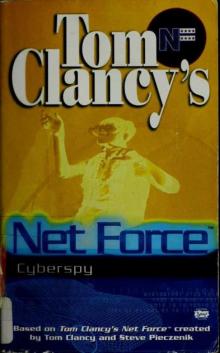 Cyberspy
Cyberspy Point of Contact
Point of Contact Operation Barracuda (2005)
Operation Barracuda (2005) Choke Point
Choke Point Power and Empire
Power and Empire Every Man a Tiger: The Gulf War Air Campaign
Every Man a Tiger: The Gulf War Air Campaign Endgame (1998)
Endgame (1998) EndWar: The Missing
EndWar: The Missing Splinter Cell (2004)
Splinter Cell (2004) The Great Race
The Great Race True Faith and Allegiance
True Faith and Allegiance Deathworld
Deathworld Ghost Recon (2008)
Ghost Recon (2008) Duel Identity
Duel Identity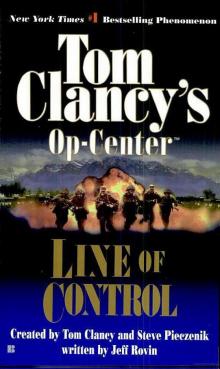 Line of Control o-8
Line of Control o-8 The Hunt for Red October jr-3
The Hunt for Red October jr-3 Hidden Agendas nf-2
Hidden Agendas nf-2 Acts of War oc-4
Acts of War oc-4 Ruthless.Com pp-2
Ruthless.Com pp-2 Night Moves
Night Moves The Hounds of Rome - Mystery of a Fugitive Priest
The Hounds of Rome - Mystery of a Fugitive Priest Into the Storm: On the Ground in Iraq sic-1
Into the Storm: On the Ground in Iraq sic-1 Threat Vector jrj-4
Threat Vector jrj-4 Combat Ops gr-2
Combat Ops gr-2 Virtual Vandals nfe-1
Virtual Vandals nfe-1 Runaways nfe-16
Runaways nfe-16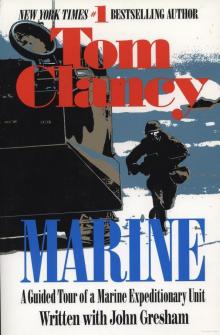 Marine: A Guided Tour of a Marine Expeditionary Unit tcml-4
Marine: A Guided Tour of a Marine Expeditionary Unit tcml-4 Shadow Warriors: Inside the Special Forces sic-3
Shadow Warriors: Inside the Special Forces sic-3 Jack Ryan Books 1-6
Jack Ryan Books 1-6 Cold Case nfe-15
Cold Case nfe-15 Changing of the Guard nf-8
Changing of the Guard nf-8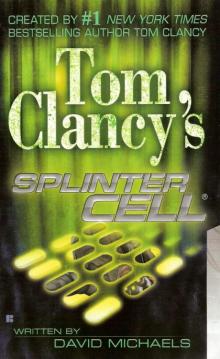 Splinter Cell sc-1
Splinter Cell sc-1 Battle Ready sic-4
Battle Ready sic-4 The Bear and the Dragon jrao-11
The Bear and the Dragon jrao-11 Fighter Wing: A Guided Tour of an Air Force Combat Wing tcml-3
Fighter Wing: A Guided Tour of an Air Force Combat Wing tcml-3 Patriot Games jr-1
Patriot Games jr-1 Jack Ryan Books 7-12
Jack Ryan Books 7-12 Mission of Honor o-9
Mission of Honor o-9 Private Lives nfe-9
Private Lives nfe-9 Operation Barracuda sc-2
Operation Barracuda sc-2 Cold War pp-5
Cold War pp-5 Point of Impact nf-5
Point of Impact nf-5 Red Rabbit jr-9
Red Rabbit jr-9 The Deadliest Game nfe-2
The Deadliest Game nfe-2 Springboard nf-9
Springboard nf-9 Safe House nfe-10
Safe House nfe-10 EndWar e-1
EndWar e-1 Duel Identity nfe-12
Duel Identity nfe-12 Deathworld nfe-13
Deathworld nfe-13 Politika pp-1
Politika pp-1 Rainbow Six jr-9
Rainbow Six jr-9 Tom Clancy's Power Plays 1 - 4
Tom Clancy's Power Plays 1 - 4 Endgame sc-6
Endgame sc-6 Executive Orders jr-7
Executive Orders jr-7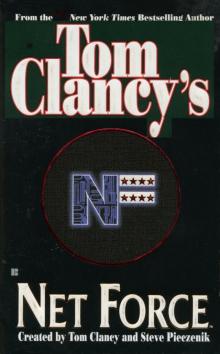 Net Force nf-1
Net Force nf-1 Call to Treason o-11
Call to Treason o-11 Locked On jrj-3
Locked On jrj-3 Against All Enemies
Against All Enemies The Sum of All Fears jr-7
The Sum of All Fears jr-7 Sea of Fire o-10
Sea of Fire o-10 Fallout sc-4
Fallout sc-4 Balance of Power o-5
Balance of Power o-5 Shadow Watch pp-3
Shadow Watch pp-3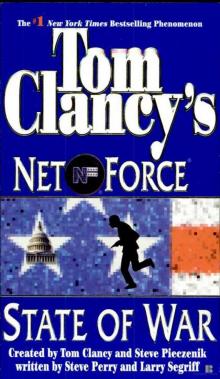 State of War nf-7
State of War nf-7 Wild Card pp-8
Wild Card pp-8 Games of State o-3
Games of State o-3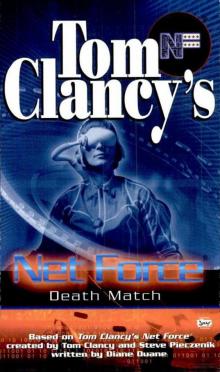 Death Match nfe-18
Death Match nfe-18 Against All Enemies mm-1
Against All Enemies mm-1 Every Man a Tiger: The Gulf War Air Campaign sic-2
Every Man a Tiger: The Gulf War Air Campaign sic-2 Cybernation nf-6
Cybernation nf-6 Support and Defend
Support and Defend Night Moves nf-3
Night Moves nf-3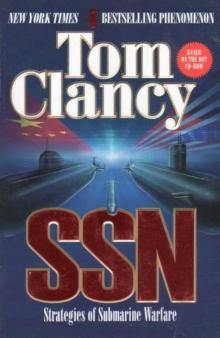 SSN
SSN Cutting Edge pp-6
Cutting Edge pp-6 The Cardinal of the Kremlin jrao-5
The Cardinal of the Kremlin jrao-5 War of Eagles o-12
War of Eagles o-12 Op-Center o-1
Op-Center o-1 Mirror Image o-2
Mirror Image o-2 The Archimedes Effect nf-10
The Archimedes Effect nf-10 Teeth of the Tiger jrj-1
Teeth of the Tiger jrj-1 Bio-Strike pp-4
Bio-Strike pp-4 State of Siege o-6
State of Siege o-6 Debt of Honor jr-6
Debt of Honor jr-6 Zero Hour pp-7
Zero Hour pp-7 Ghost Recon gr-1
Ghost Recon gr-1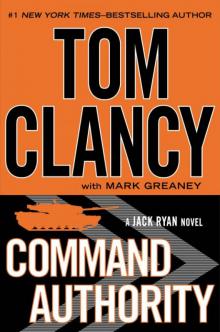 Command Authority jr-10
Command Authority jr-10 Tom Clancy's Power Plays 5 - 8
Tom Clancy's Power Plays 5 - 8 Checkmate sc-3
Checkmate sc-3 Breaking Point nf-4
Breaking Point nf-4 Gameprey nfe-11
Gameprey nfe-11 The Hunted e-2
The Hunted e-2 Hidden Agendas
Hidden Agendas Divide and Conquer o-7
Divide and Conquer o-7